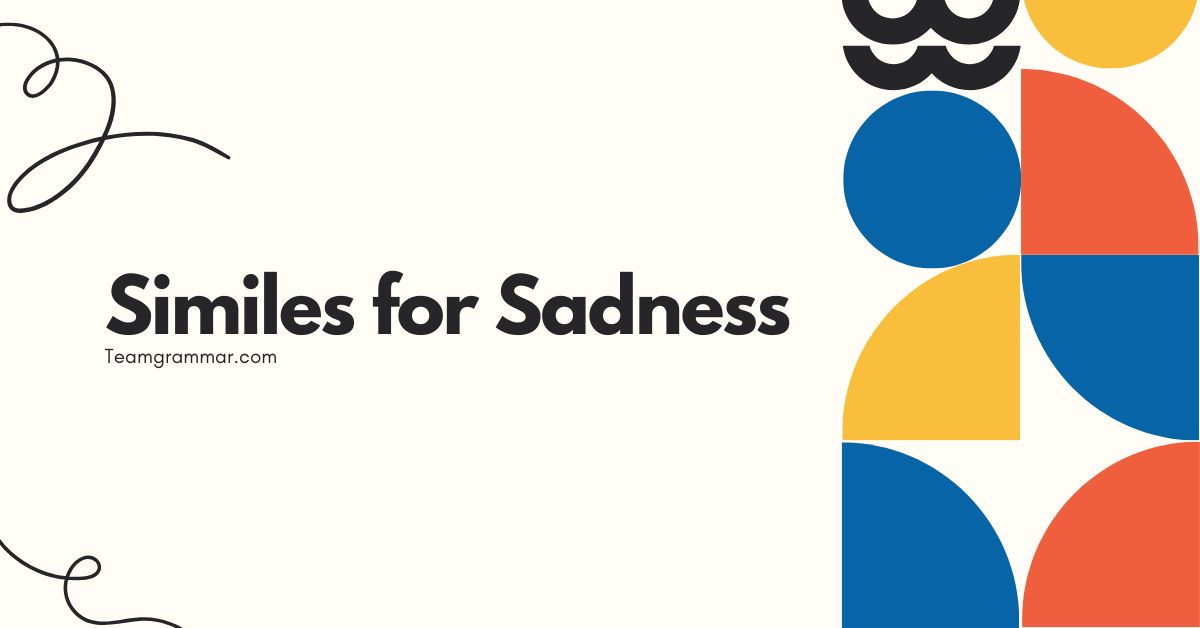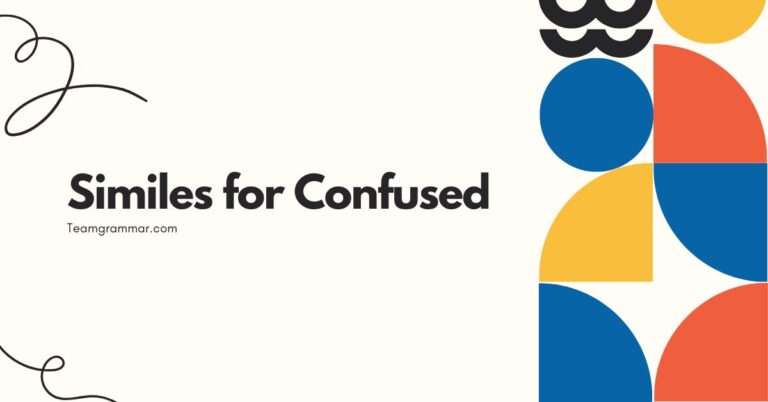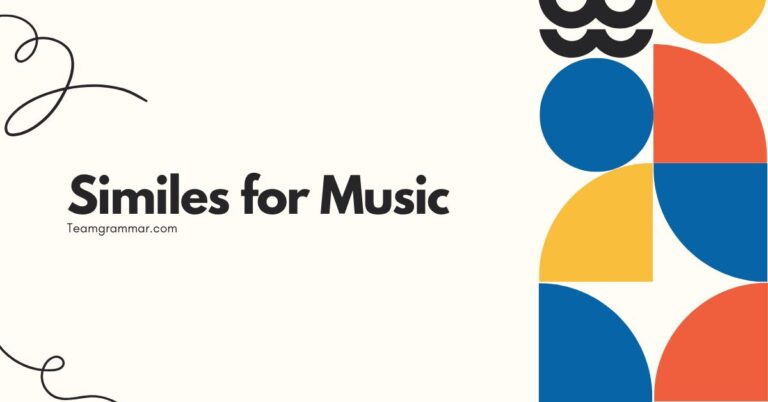33 Similes for Sadness: Enhancing Emotional Expression
Understanding and expressing emotions effectively is crucial for communication and connection. Sadness, a fundamental human emotion, can be conveyed through various linguistic devices, and similes offer a powerful way to articulate its nuances.
This article delves into the realm of similes used to describe sadness, exploring their structure, types, and usage. Whether you are a student, writer, or simply someone seeking to expand your emotional vocabulary, this guide will provide you with the tools to express sadness with greater depth and precision.
Table of Contents
- Introduction
- Definition of Simile
- Function of Similes in Expressing Sadness
- Structural Breakdown of Similes
- Types of Similes for Sadness
- Examples of Similes for Sadness
- Usage Rules for Similes
- Common Mistakes When Using Similes
- Practice Exercises
- Advanced Topics: Nuances in Simile Usage
- Frequently Asked Questions
- Conclusion
Definition of Simile
A simile is a figure of speech that compares two unlike things using the words “like” or “as.” It is a powerful tool in writing and speech, allowing for vivid and imaginative descriptions. Similes help to create a clearer and more relatable image in the reader’s or listener’s mind by drawing a connection between something familiar and something less known or abstract.
This connection enhances understanding and emotional impact.
Function of Similes in Expressing Sadness
When used to describe sadness, similes can effectively convey the intensity, depth, and specific characteristics of this emotion. They go beyond simply stating “I am sad” by providing a sensory or emotional comparison that resonates with the audience.
For instance, saying “He felt as heavy as lead” paints a much more vivid picture of the burden of sadness than simply saying “He was sad.” Similes allow us to explore the multifaceted nature of sadness, from the quiet ache of loneliness to the overwhelming weight of grief.
Structural Breakdown of Similes
The basic structure of a simile consists of three key elements: the subject being described (the feeling of sadness), the comparison word (“like” or “as”), and the object or idea to which the subject is being compared. The comparison should highlight a shared quality or characteristic between the two.
Understanding this structure allows for the creation of effective and evocative similes.
A simile typically follows the pattern: [Subject (feeling sad)] + [Comparison Word (like/as)] + [Object of Comparison]. For example:
- Her heart felt like a stone. (Subject: Her heart; Comparison Word: like; Object of Comparison: a stone)
- He was as lost as a ship without a rudder. (Subject: He; Comparison Word: as; Object of Comparison: a ship without a rudder)
Types of Similes for Sadness
Similes for sadness can be categorized based on the specific aspect of sadness they aim to capture. These categories include similes describing despair, loneliness, grief, disappointment, and general sadness.
Each category utilizes different imagery and comparisons to evoke the specific emotional tone.
Similes Describing Despair
Despair is a state of complete hopelessness and loss of courage. Similes used to describe despair often evoke images of darkness, emptiness, and entrapment.
They aim to convey the feeling of being utterly overwhelmed and without any prospect of relief.
Similes Describing Loneliness
Loneliness is the feeling of being isolated and alone. Similes for loneliness often use imagery of empty spaces, silence, and separation.
They highlight the lack of connection and the longing for companionship.
Similes Describing Grief
Grief is the intense sorrow caused by loss, especially the death of a loved one. Similes describing grief often involve images of pain, emptiness, and a sense of being broken.
They aim to capture the overwhelming and often debilitating nature of grief.
Similes Describing Disappointment
Disappointment is the feeling of sadness or dissatisfaction caused by the non-fulfillment of one’s hopes or expectations. Similes for disappointment often use imagery of broken objects, withered plants, or unrealized dreams.
They convey the feeling of something being diminished or lost.
Similes Describing General Sadness
General sadness encompasses a broad range of negative emotions that don’t necessarily fall into the specific categories above. These similes often use imagery of weight, darkness, and muted colors to convey a general sense of unhappiness and melancholy.
Examples of Similes for Sadness
The following tables provide extensive examples of similes used to describe various aspects of sadness. Each table focuses on a specific category, offering a wide range of comparisons to enhance your understanding and vocabulary.
Similes Describing Despair
This table shows examples of similes that demonstrate the feeling of despair. The similes utilize imagery of darkness, entrapment, and hopelessness to convey the intense feeling of despair.
| Simile | Explanation |
|---|---|
| He felt as lost as a ship without a compass. | Describes a feeling of being completely directionless and without hope. |
| Her despair was like a bottomless pit. | Conveys the sense of endless, inescapable sorrow. |
| The world seemed as bleak as a winter landscape. | Highlights the lack of color and life, mirroring the internal state of despair. |
| His hopes crumbled like sandcastles before the tide. | Illustrates the swift and complete destruction of aspirations. |
| She felt as trapped as a bird in a cage. | Conveys the feeling of being confined and unable to escape one’s circumstances. |
| His spirit was as broken as a shattered mirror. | Emphasizes the irreparable damage and fragmentation of the self. |
| The silence was like a heavy shroud, suffocating all hope. | Depicts the oppressiveness and hopelessness of silence in despair. |
| He felt like Sisyphus, eternally pushing a boulder uphill. | Illustrates the futility and endless struggle of despair. |
| Her heart was as heavy as a lead weight. | Conveys the burden and oppressiveness of despair. |
| The future seemed as dark as a moonless night. | Highlights the lack of hope and the overwhelming sense of uncertainty. |
| His dreams were as fragile as glass, easily shattered. | Emphasizes the vulnerability and ease with which hopes can be destroyed. |
| She felt like a marionette, controlled by unseen forces. | Conveys the feeling of being powerless and manipulated by external circumstances. |
| He was as empty as a hollow shell. | Illustrates the profound sense of inner emptiness and lack of substance. |
| Her despair was like a dense fog, obscuring all light. | Depicts the suffocating and disorienting nature of despair. |
| He felt as if he were drowning in a sea of sorrow. | Conveys the overwhelming and suffocating nature of despair. |
| Her spirit was as withered as a dying plant. | Emphasizes the loss of vitality and energy associated with despair. |
| He felt like a ghost, haunting his own life. | Illustrates the sense of detachment and alienation from one’s own existence. |
| Her hopes were as barren as a desert landscape. | Depicts the lack of possibilities and the sense of emptiness. |
| He was as lost as a wanderer in a maze. | Conveys the feeling of being disoriented and unable to find a way out. |
| Her despair was like a cold, relentless wind. | Depicts the harsh and unforgiving nature of despair. |
| He felt like he was trapped in quicksand, unable to escape. | Illustrates the feeling of being stuck and unable to move forward. |
| Her smile was as fake as a painted mask, hiding the despair within. | Emphasizes the contrast between outward appearance and inner turmoil. |
| He was as numb as if he had been frozen in ice. | Conveys the emotional detachment and lack of feeling associated with despair. |
Similes Describing Loneliness
This table provides examples of similes that capture the feeling of loneliness. These similes utilize imagery of empty spaces, silence, and isolation to convey the profound sense of being alone.
| Simile | Explanation |
|---|---|
| He felt as alone as a single star in the vast sky. | Emphasizes the isolation and insignificance of being alone. |
| Her loneliness was like an empty room. | Conveys the feeling of emptiness and lack of warmth or connection. |
| He felt like an island, separated from the mainland. | Illustrates the feeling of being isolated and disconnected from others. |
| She was as solitary as a lighthouse keeper. | Depicts the sense of being alone and responsible, with no one to share the burden. |
| His heart ached like a lonely wolf howling at the moon. | Conveys the deep, primal longing for companionship. |
| Her voice was as lost as a whisper in the wind. | Emphasizes the feeling of being unheard and insignificant. |
| He felt like a stranger in a foreign land. | Illustrates the sense of alienation and disconnection from one’s surroundings. |
| Her loneliness was like a thick fog, isolating her from the world. | Depicts the suffocating and disorienting nature of loneliness. |
| He was as isolated as a hermit in a mountain cave. | Conveys the extreme sense of seclusion and detachment from society. |
| Her laughter sounded as hollow as an echo in a canyon. | Emphasizes the emptiness and lack of genuine joy. |
| He felt like an old book, forgotten on a dusty shelf. | Illustrates the feeling of being neglected and unappreciated. |
| Her presence was as unnoticed as a shadow in the night. | Depicts the sense of invisibility and insignificance. |
| He was as adrift as a boat without sails. | Conveys the feeling of being without direction or purpose. |
| Her tears fell as silently as raindrops in the desert. | Emphasizes the lack of comfort or solace in her sorrow. |
| He felt like a ghost, wandering through a crowded room. | Illustrates the sense of being present but unseen and disconnected. |
| Her loneliness was like a barren field, devoid of life. | Depicts the emptiness and lack of connection in her life. |
| He was as unwanted as a weed in a garden. | Conveys the feeling of being rejected and unwelcome. |
| Her smile was as rare as a sunny day in winter. | Emphasizes the infrequency and preciousness of moments of happiness. |
| He felt like a broken record, repeating the same lonely tune. | Illustrates the repetitive and unchanging nature of his loneliness. |
| Her heart was as cold as a winter night. | Conveys the emotional detachment and lack of warmth. |
| He was as invisible as a chameleon in the forest. | Depicts the sense of being unnoticed and blending into the background. |
| Her voice was as faint as a distant memory. | Emphasizes the fading and ephemeral nature of her presence. |
| He felt like a forgotten toy, gathering dust in the attic. | Illustrates the feeling of being neglected and no longer valued. |
Similes Describing Grief
This table provides examples of similes to portray grief. These similes utilize imagery of pain, emptiness, and brokenness to convey the overwhelming and often debilitating nature of grief.
| Simile | Explanation |
|---|---|
| Her grief was like a gaping wound that would not heal. | Conveys the sense of deep, persistent pain. |
| He felt as if his heart had been ripped from his chest. | Emphasizes the intense physical and emotional pain of loss. |
| Her tears flowed like a river, unending and relentless. | Depicts the overwhelming and uncontrollable nature of sorrow. |
| He was as numb as if he had been struck by lightning. | Illustrates the emotional shock and paralysis of grief. |
| Her world felt as shattered as a dropped vase. | Conveys the sense of irreparable damage and fragmentation. |
| His grief was like a heavy cloak, weighing him down. | Depicts the burden and oppressiveness of sorrow. |
| She felt as empty as a deserted house. | Emphasizes the profound sense of loss and absence. |
| His memories were as sharp as shards of glass, cutting him deeply. | Conveys the painful and piercing nature of memories. |
| Her laughter was as silent as a graveyard. | Depicts the absence of joy and the pervasive sense of mourning. |
| He felt as if he were drowning in a sea of tears. | Illustrates the overwhelming and suffocating nature of grief. |
| Her heart was as broken as a shattered mirror. | Conveys the irreparable damage and fragmentation of the self. |
| His pain was like a fire, consuming him from the inside. | Depicts the intense and destructive nature of grief. |
| She felt as lost as a child in a dark forest. | Emphasizes the sense of vulnerability and disorientation. |
| His grief was like a shadow, following him everywhere. | Depicts the constant and inescapable presence of sorrow. |
| Her voice was as weak as a whisper in the wind. | Conveys the physical and emotional exhaustion of grief. |
| He felt like a ship without a rudder, lost at sea. | Illustrates the feeling of being without direction or purpose. |
| Her world was as colorless as a black and white photograph. | Depicts the lack of vibrancy and joy in her life. |
| His grief was like a persistent ache, never fully subsiding. | Conveys the enduring and unrelenting nature of sorrow. |
| She felt as if a part of her had died with him. | Emphasizes the profound sense of loss and diminishment. |
| His memories were as precious as a rare jewel. | Conveys the value and significance of the memories of the loved one. |
| Her sorrow was as deep as the ocean. | Illustrates the immeasurable and profound nature of her grief. |
| He felt like an empty shell, devoid of life and purpose. | Depicts the profound sense of inner emptiness and lack of substance. |
| Her smiles were as rare as shooting stars. | Emphasizes the infrequency and preciousness of moments of happiness. |
| His heart was as cold as ice after the loss. | Conveys the emotional detachment and lack of warmth. |
Similes Describing Disappointment
This table lists similes that capture the feeling of disappointment. These similes use imagery of broken objects, withered plants, or unrealized dreams to convey the feeling of something being diminished or lost.
| Simile | Explanation |
|---|---|
| His hopes were as dashed as a glass against a wall. | Conveys the sudden and complete destruction of aspirations. |
| Her dreams withered like a flower without water. | Depicts the gradual decay and loss of vitality. |
| He felt as deflated as a punctured balloon. | Illustrates the sudden loss of energy and enthusiasm. |
| Her expectations were as shattered as a broken mirror. | Conveys the irreparable damage and fragmentation of hopes. |
| His efforts were as futile as trying to catch the wind. | Depicts the sense of pointlessness and lack of progress. |
| Her plans crumbled like a house of cards. | Conveys the fragility and instability of her ambitions. |
| He was as let down as a tightrope walker without a net. | Illustrates the feeling of vulnerability and insecurity. |
| Her joy was as fleeting as a summer breeze. | Depicts the brief and ephemeral nature of happiness. |
| His ambitions were as barren as a desert landscape. | Conveys the lack of potential and the sense of emptiness. |
| She felt as if her wings had been clipped. | Illustrates the feeling of being restricted and unable to achieve her goals. |
| His enthusiasm was as dampened as a wet firework. | Depicts the diminished and lackluster nature of his passion. |
| Her hopes were as fragile as thin ice. | Conveys the vulnerability and ease with which her aspirations could be destroyed. |
| He felt like a ship that had run aground, stuck and unable to move. | Illustrates the feeling of being stranded and unable to progress. |
| Her expectations were as unrealistic as chasing rainbows. | Depicts the unattainable nature of her goals. |
| His efforts were as fruitless as plowing sand. | Conveys the sense of wasted effort and lack of reward. |
| She felt like a runner who had tripped just before the finish line. | Illustrates the disappointment of nearly achieving success. |
| His dreams were as distant as stars in the night sky. | Depicts the remoteness and unattainability of his aspirations. |
| Her plans were as incomplete as a puzzle with missing pieces. | Conveys the sense of something lacking and preventing completion. |
| He felt like a student who had failed a crucial exam. | Illustrates the disappointment and setback of not meeting expectations. |
| Her joy was as temporary as a soap bubble. | Depicts the brief and easily broken nature of happiness. |
| His hopes were as fragile as a butterfly’s wings. | Conveys the vulnerability and delicate nature of his aspirations. |
| She felt like a deflated tire, unable to move forward. | Illustrates the feeling of being stuck and unable to progress. |
| His smile was as forced as someone trying to hide their true feelings. | Emphasizes the contrast between outward appearance and inner disappointment. |
Similes Describing General Sadness
This table lists similes that capture the feeling of general sadness. These similes use imagery of weight, darkness, and muted colors to convey a general sense of unhappiness and melancholy.
| Simile | Explanation |
|---|---|
| He felt as heavy as a stone. | Conveys the burden and oppressiveness of sadness. |
| Her sadness was like a gray cloud. | Depicts the dullness and gloominess of her mood. |
| He was as downcast as a weeping willow. | Illustrates the drooping and dejected posture. |
| Her heart felt like lead. | Conveys the heaviness and emotional burden of sadness. |
| His spirit was as low as the tide. | Depicts the diminished energy and enthusiasm. |
| Her mood was like a rainy day. | Conveys the gloominess and dreariness of her emotions. |
| He felt as blue as the deep sea. | Illustrates the profound depth and intensity of his sadness. |
| Her laughter was as rare as a rainbow on a cloudy day. | Depicts the infrequency and preciousness of moments of happiness. |
| He was as somber as a funeral march. | Conveys the solemn and mournful nature of his mood. |
| Her smile was as faint as a ghost. | Illustrates the weak and insubstantial nature of her happiness. |
| He felt like a shadow of his former self. | Depicts the diminished and weakened state. |
| Her eyes were as tearful as a spring shower. | Conveys the overflowing and uncontrollable nature of her sadness. |
| He was as melancholic as a sad song. | Illustrates the mournful and reflective nature of his mood. |
| Her spirit was as subdued as a caged bird. | Depicts the suppressed and restrained nature of her emotions. |
| He felt like he was walking through mud. | Conveys the difficulty and sluggishness of his emotional state. |
| Her voice was as quiet as a whisper. | Illustrates the subdued and withdrawn nature of her communication. |
| He was as despondent as a prisoner in his cell. | Depicts the feeling of being trapped and without hope. |
| Her mood was as heavy as a storm cloud. | Conveys the oppressiveness and foreboding nature of her emotions. |
| He felt like the world was against him. | Illustrates the feeling of being opposed and unsupported. |
| Her sadness was as pervasive as the scent of rain. | Depicts the all-encompassing and inescapable nature of her sorrow. |
| He was as gloomy as a November day. | Conveys the dreariness and lack of light in his mood. |
| Her heart was as dark as a moonless night. | Illustrates the absence of joy and hope. |
| He felt like he was carrying the weight of the world on his shoulders. | Depicts the immense burden and responsibility he felt. |
Usage Rules for Similes
While similes are a creative tool, there are some rules to follow to ensure they are effective and clear. The comparison should be logical and relatable to the audience.
Avoid clichés, as they lose their impact through overuse. Ensure that the two things being compared are indeed unlike in most respects, but share a specific quality that enhances the description.
Key rules to remember:
- Use “like” or “as”: These are the defining words of a simile.
- Ensure a clear comparison: The connection between the two things being compared should be evident.
- Avoid clichés: Overused similes can sound unoriginal and weaken your writing.
- Be specific: The more specific the comparison, the more vivid the image.
- Consider your audience: Make sure the comparison is relatable to your target audience.
Common Mistakes When Using Similes
One common mistake is using similes that are too generic or cliché, such as “as sad as can be.” Another mistake is making comparisons that don’t make sense or are too far-fetched. For example, “He was as sad as a refrigerator” doesn’t create a clear or meaningful image.
It’s also important to avoid mixing metaphors and similes, which can create confusing and contradictory imagery.
Here are some examples of common mistakes and how to correct them:
| Incorrect | Correct | Explanation |
|---|---|---|
| He was as sad as sad. | He was as sad as a rainy day. | The incorrect simile is redundant and doesn’t provide any additional information. |
| She was as lonely as a rock. | She was as lonely as a single tree on a barren hill. | The incorrect simile is too vague and doesn’t create a strong image. |
| His grief was like a car. | His grief was like a heavy weight on his shoulders. | The incorrect simile is unrelated and doesn’t make sense in context. |
| She was as disappointed as a broken heart. | She was as disappointed as a child who didn’t receive a birthday present. | The incorrect simile is a cliché and doesn’t add any originality. |
Practice Exercises
Test your understanding of similes for sadness with these exercises. Fill in the blanks to complete the similes, or create your own similes based on the given prompts.
Exercise 1: Complete the Simile
Fill in the blanks to complete the following similes.
| Question | Answer |
|---|---|
| He felt as alone as a ______ in the vast sky. | star |
| Her sadness was like a ______ cloud. | gray |
| His heart felt like ______. | lead |
| She was as disappointed as a ______ balloon. | punctured |
| His grief was like a ______ wound. | gaping |
| He felt as heavy as a ______. | stone |
| Her loneliness was like an ______ room. | empty |
| His hopes were as dashed as ______ against a wall. | glass |
| She felt as if her wings had been ______. | clipped |
| His spirit was as low as the ______. | tide |
Exercise 2: Create Your Own Simile
Write a simile for each of the following prompts.
| Prompt | Answer (Example) |
|---|---|
| Describe the feeling of despair. | His despair was like a bottomless pit. |
| Describe the feeling of loneliness. | She felt as alone as a single leaf falling from a tree. |
| Describe the feeling of grief. | His grief was like a heavy cloak, weighing him down. |
| Describe the feeling of disappointment. | Her dreams withered like a flower without water. |
| Describe a general feeling of sadness. | He felt as blue as the deep sea. |
| Describe the feeling of being heartbroken. | Her heart was as broken as a shattered vase. |
| Describe the feeling of isolation. | He felt like an island, separated from the mainland. |
| Describe the feeling of hopelessness. | Her hopes were as barren as a desert landscape. |
| Describe the feeling of emptiness. | He was as empty as a hollow shell. |
| Describe the feeling of being overwhelmed by sadness. | She felt as if she were drowning in a sea of tears. |
Advanced Topics: Nuances in Simile Usage
For advanced learners, exploring the nuances of simile usage can elevate their writing. This includes understanding how cultural context influences the effectiveness of a simile, as well as the subtle differences between similes and metaphors.
Experimenting with extended similes, where the comparison is developed over several sentences, can also create a more powerful and lasting impression.
Consider these advanced techniques:
- Cultural Context: Be aware of cultural references that might not be universally understood.
- Simile vs. Metaphor: Understand the subtle differences and choose the most appropriate figure of speech.
- Extended Similes: Develop the comparison over multiple sentences for greater impact.
- Originality: Strive for unique and imaginative comparisons that haven’t been overused.
- Sensory Details: Incorporate sensory details to make the simile more vivid and relatable.
Frequently Asked Questions
Here are some frequently asked questions about similes and their usage.
- What is the difference between a simile and a metaphor?
A simile compares two things using “like” or “as,” while a metaphor states that one thing is another thing. For example, “He is as brave as a lion” (simile) vs. “He is a lion” (metaphor). - Why are similes useful in writing?
Similes add vividness, clarity, and emotional impact to writing. They help readers visualize and understand abstract concepts by relating them to something familiar. - How can I avoid using clichés in my similes?
Read widely and pay attention to the language used by other writers. Try to come up with original comparisons that are specific and imaginative. - Can a simile be too complex?
Yes, if the comparison is too obscure or requires too much background knowledge, it can confuse the reader. Aim for clarity and relatability. - Is it okay to use multiple similes in one paragraph?
Yes, but use them sparingly. Too many similes can make your writing feel cluttered and overwhelming. - How do I choose the right simile for a particular emotion?
Consider the specific nuances of the emotion you want to convey. Think about what images or sensations best capture that feeling, and then create a comparison that reflects those qualities. - Are similes only used in creative writing?
No, similes can be used in various forms of writing, including persuasive essays, speeches, and even technical reports, to make complex information more accessible. - How can I improve my ability to create effective similes?
Practice regularly, read widely, and pay attention to the world around you. The more you observe and analyze, the better you’ll become at making insightful comparisons. - What role does context play in the effectiveness of a simile?
Context is crucial. A simile that works well in one situation might be inappropriate or confusing in another. Consider the audience, the tone of the writing, and the overall message you want to convey. - How can I use similes to enhance emotional expression in my writing?
Similes can bridge the gap between abstract feelings and concrete imagery. By comparing emotions to tangible things, you make them more relatable and impactful for the reader. For instance, comparing sadness to a “heavy cloak” helps readers feel the weight of the emotion.
Conclusion
Mastering the use of similes, especially those
describing sadness, can significantly enhance your ability to express emotions with depth and clarity. By understanding the structure, types, and usage rules of similes, you can craft vivid and impactful descriptions that resonate with your audience.
Practice regularly, avoid common mistakes, and explore advanced techniques to elevate your writing and communication skills. Whether you’re a writer, student, or simply someone seeking to expand your emotional vocabulary, the power of similes will enable you to articulate the nuances of sadness with greater precision and empathy.







